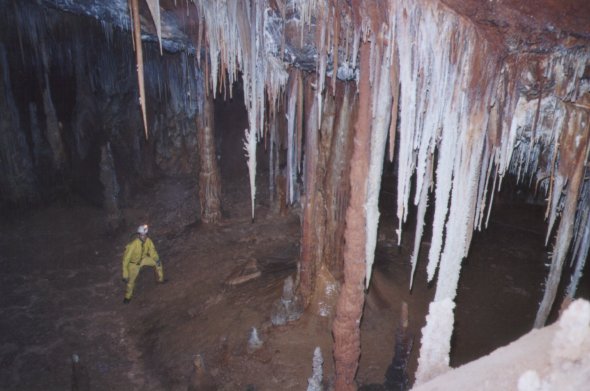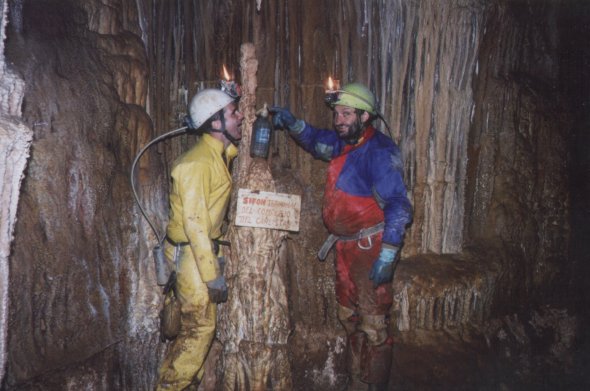Spanish Trip 2002
Six members of Bracknell District Caving Club (BDCC), Biff Frith, Karen Goodman, Mark Pearson, Bill Chadwick, Doug Harris and Mick Norton made a two week trip to Cantabria in Northern Spain at the beginning of September 2002. Simon Kay, also of BDCC, joined them in Spain for the first week. Mick Norton, Doug Harris and Bill Chadwick are also members of Mendip Caving Group (MCG).
Thanks to Richard Carey of MCG for liasing, in Spanish, with the hosts of our accommodation before our trip.
Some of the cave entrances are tricky to find. A GPS receiver helps a lot. The UTM Grid Co-ordinates listed herein are on the European Datum. There are some good 1:20000 local maps available that have many of the major caves marked. They are published by CETYMA. We got them in a huge outdoor store at an out of town shopping centre in Santander. The same store also sold a bit of caving gear.
The climate was perfect, nearly 30 degrees every day. Cantabria is very green and lush. Most days started misty but cleared quickly to warm sunshine. We did not experience any significant daytime rain.
These words are by Bill Chadwick. The photos are by myself and Biff Frith.
Travel
Six of us travelled by Biff's Minibus using the Channel Tunnel. The drive from Calais to Ramales de la Victoria in Cantabria took about 15 hours each way. We travelled by toll Autoroute as much as possible. On the way out, Mark took us through the middle of Paris at midnight! Simon travelled by Motorbike. One advantage of the channel tunnel is that the number of passengers is open. Approximate expenditure was £462 for the Tunnel, £65 AA Five Star, £50 extra driver insurance, £46 each for BCRA Expedition Insurance, € 343 for Diesel and € 210 for Tolls.
Accommodation
We stayed at the Casa Tomas in Oggario, close by to Ramales. This is a Bar / Restaurant / Rooms establishment, used to cavers. The rooms have 3 single beds each and a toilet, small bath and shower. Our beds were made and the room tidied every day. Two of the three rooms we had had small balconies with good views of the hills. We had full board. Dinners were a large, four-course affair with wine, much more than we could eat. Breakfast included cooked ham and eggs. A packed lunch of baguette, canned drinks, cake and fruit was provided every day. All of this cost a mere € 23.5 per day! Casa Tomas is the only bar in Oggario. There is no shop there, just a lot of small farms and cows! We saw a few donkeys carrying milk and the odd horse and cart carrying fodder.
To book accommodation at Casa Tomas call Eva on 00 34 942641120, she speaks a very small amount of English. It would make a splendid base for a walking holiday.
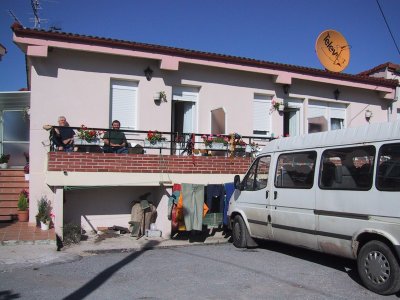 |
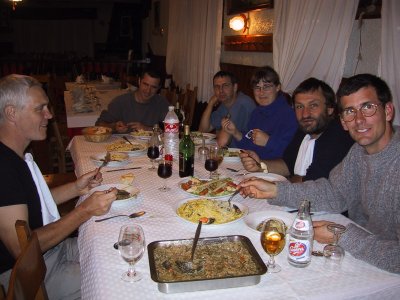 |
A hose for kit washing and a drying line were available outside our rooms. Rope washing was conducted in a nearby stretch of river (out of the village on a minor road towards Riba/Arredondo).
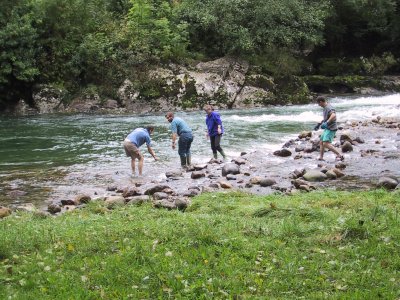 |
There is a caving shop in Ramales where the staff are very friendly and speak a little English. They lent us their own local cave guide books which we photocopied in a shop in town. They have some interesting own brand under and over suits. Their address is MTDE-Espana, Barrio El Mazo, 14 39800, Ramales de la Victoria, Cantabria, http://www.mtde.net.
The local caving club can be contacted via their web site at http://www.aer-espeleo.com, some of which is in English. Access details will be found there. None of the caves we visited had controlled access.
Caving
We visited a number of caves. The four larger ones are described in the following sections. None were far from Casa Tomas.
Cueva Canuela or Cayuela
The entrance can be clearly seen from across the valley but is hard to find. It's the black hole at the top of the steep grassy slope in the middle of the left hand picture below. The co-ordinates of the cave are 30T 449660 4791720 at an altitude of 305m.
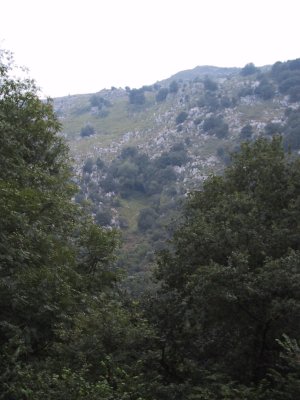 |
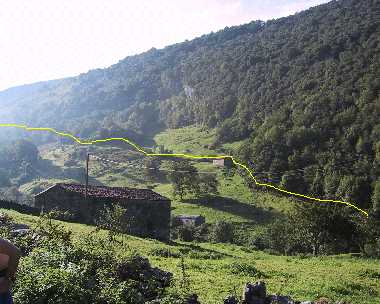 |
We parked by the south side of the Arredondo to Bustablado road at 30T 0449195 4792133 where the right hand photo above is taken from. We asked permission from the house up on the left just back down the road towards Arredondo. We crossed a bridge over the small stream at the bottom of the valley side and climbed a well-worn path diagonally up the side of the hill. Then we went wrong. We could hear the woman from the house shouting at us and see her waving but understood nothing. As if my magic, a herdsman appeared and offered to show us the way. We passed around two cowsheds and then regained a small path that led horizontally along the hill. Finally, we turned a corner to be hit by the enormous cold draught that blows from the entrance. The route is roughly marked on the photo above. The cave is not near the bottom of the cliff seen in the middle of the photo. The entrance is the 'Galeria de Entrada' on the survey below.
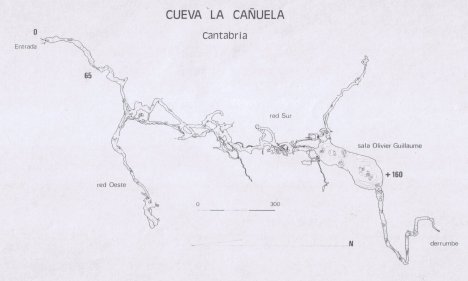 |
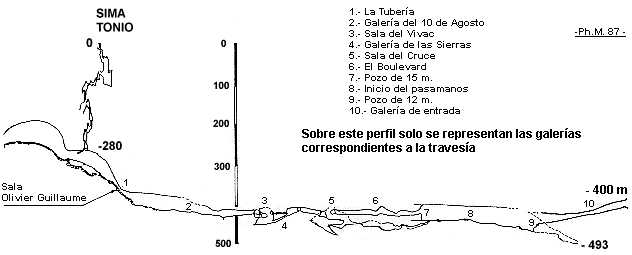 |
Once at the entrance we had to don our harnesses straight away as a grand traverse appears almost immediately. This had a fixed line in good condition. After the traverse, the going was all easy. Fixed aids are installed wherever needed, at one point there is a 15m climb up a good but very thick rope. This needed a figure of 8 to descend, as it was too big for our Petzl Stops. Progress and route finding were not hard, with way-marking reflectors appearing often. The climb up in to the final large chamber was quite strenuous. We observed a very dubious looking bit of rope hanging down from where the Sima Tonio through trip enters high up in the roof. On the way, there are some spectacular formations and enormous passages. The trip to 'Sala Olivier Guillaume' and back took us about six hours with plenty of photo stops.
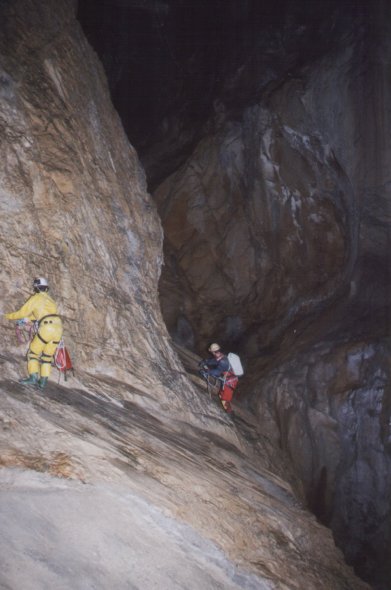 |
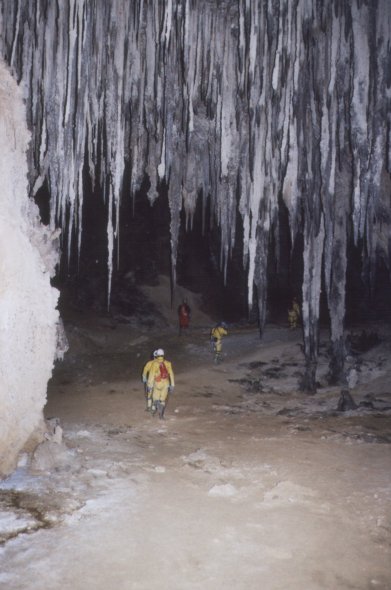 |
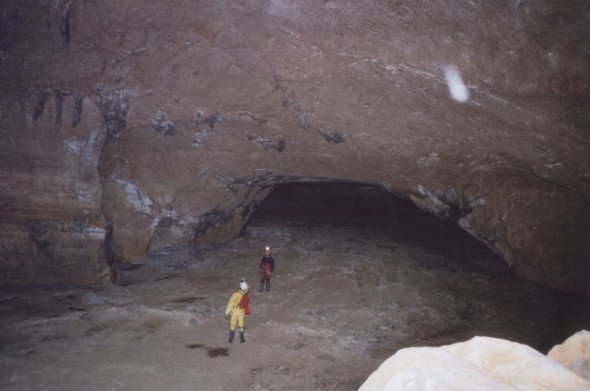 |
Torcal Del Carlista
This was the hardest of the caves we visited. It boasts the largest natural underground chamber in Europe, some 500m x 200m x 120m high. The entrance is near the top of the hill named Picon del Carlista. There is a good approach road, which has recently been resurfaced. It leads to the Pozalagua show cave. This itself is well worth a visit. It has a large area of flat roof covered in the most amazing helictites growing in loops that descend a foot or more. We parked in the lay-by, just next to the start of the path up the hill. There is an ageing wooden sign at the start of the path. We followed the path up the hill until we reached the saddle. Then we turned left and traversed around the hill. Finally we followed some cairns and climbed up a slot in a small limestone cliff. The entrance is a small chasm a little below the top of the hill towards the saddle. We needed lights for the walk back down the hill, which we made in the dark. At one point, the path passes close by the edge of a deep quarry! Below is a view of our van in the lay-by from the top of the hill and a shot of the entrance. The cave descends well below the level of the van. The published co-ordinates are 0468465, 04790150 (700m) but we recorded 0468456, 4790288 (707m).
 |
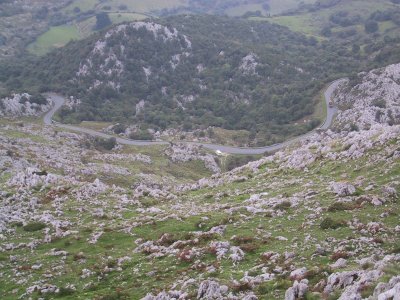 |
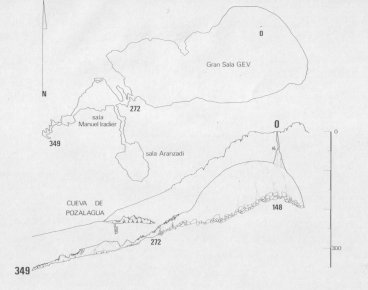 |
There are about three simple pitches to the head of the big one. We used an 80m rope for these, a little longer would have made for an easier changeover to the main drop. At the small ledge at 45m there are two beefy bolts for the main 100m drop. The ledge is big enough to wait at for a man on the big drop rope. We used an 110m rope for the big drop, which reached the floor with a bit to spare. The pitch hangs in free space and is awesome.
It took us on average half an hour each to prussik out. We were all out by about 10:00PM having entered the cave at about 11:00AM. Once at the bottom, the floor is littered with enormous boulders, some the size of houses. There is a guideline leading through this maze to the lower well-decorated part of the cave. It saved us a lot of time.
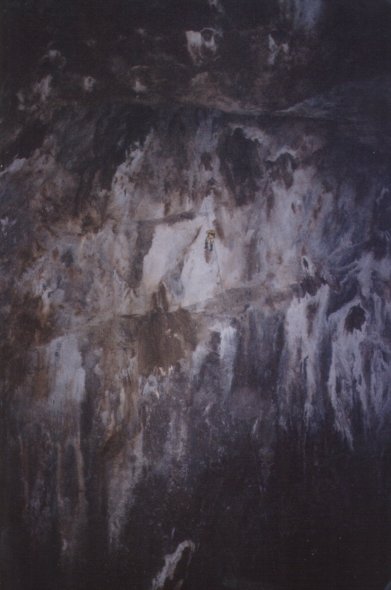 |
The great chamber is quite stupendous. The picture above is the east wall with myself descending the big pitch. After passing through the boulders of the main chamber, the formations begin. The very best are at the final chamber. There is no stream way in the cave. To make up for it there is a Soda Syphon and a sign reading 'Sifon Terminal Del Complexio Del Carlista', Sifon being Spanish for sump.
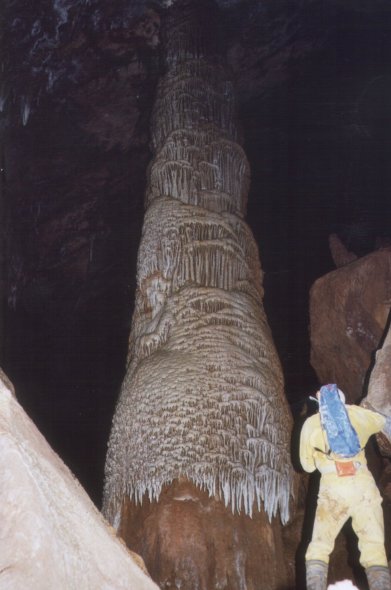 |
|
These photos show some of the formations in Carlista. The two on the right are of the Salon Terminal and the 'Sifon'
Cueva Coventosa
This is a popular cave. A major SRT through trip exists from the high altitude Cueva Cueto entrance (BDCC did this in the early 1990s). Coventosa is easy to find. Take the right turn just before the road up the Ason valley from Arredondo crosses the river. There is parking at the hamlet of Valdeason at the end of the road. From there, a well-worn path along the side of the valley reaches the entrance in about 10 minutes (passing a few cow sheds oozing noxious slurry). A huge cold draught blows out.
We made two trips into Coventosa. On our first trip we went to the first of the lakes. These are on the Cueto - Coventosa through trip. They can only be passed by dinghy. There are various small climbs and traverses on the way to the lakes. All were permanently rigged. The streamway is splendid. The trip took as about 6 hours.
Our second trip was just to view the formations near the entrance (20 minutes in). Just inside the entrance there is a 10m pitch with a shallow approach. It needs SRT kit, though there is a place for a ladder.
After our first trip, Mick had Bill help him re-find a cave he had 'found' 10 years previously. He had been unable to explore its blackness at the time, alone and with no light. After much scrambling on the very steep hillside it was duly rediscovered. By UK standards it was a large cave with enormous chambers. It had been well visited by both man and beast, having many bones and fire remains on the floor. Mick can now rest easy in his bed with out dreaming of caverns measureless to man awaiting him in Spain !
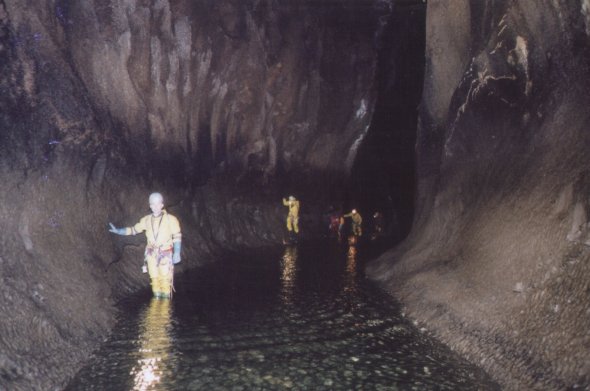 |
 |
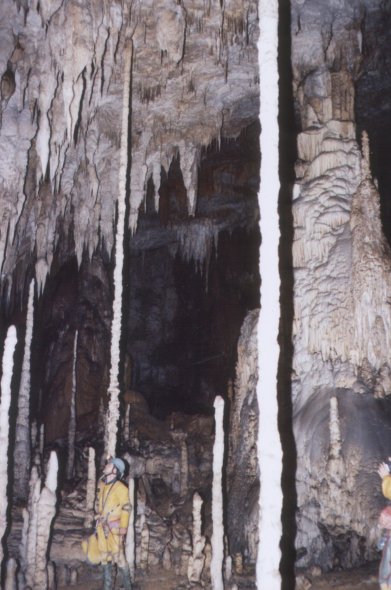 |
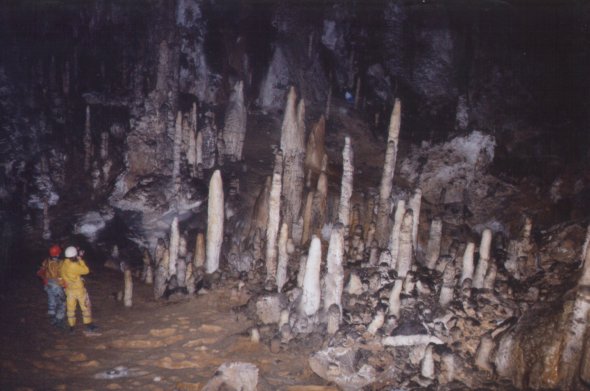 |
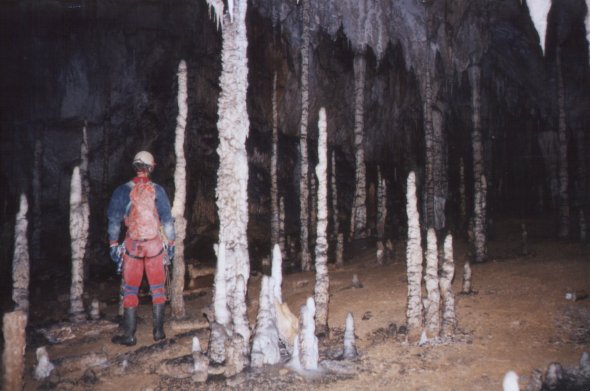 |
Cueva Fresca
This is a hard cave to find, it took us all morning and the help of some passing local cavers (we did not have the GPS with us). It's main entrance is at 30T 0468465 4790150 and an altitude of 610m. We parked by the church in the hamlet of Bo San Antonio off the Ason valley road. Then we followed a track south, over the river and passed some meadows. After the meadows, we took a fairly indistinct path on the right, straight up the side of the valley, through some woods. This crossed a small gully before emerging at the large, strongly draught entrance. It is quite an arduous climb.
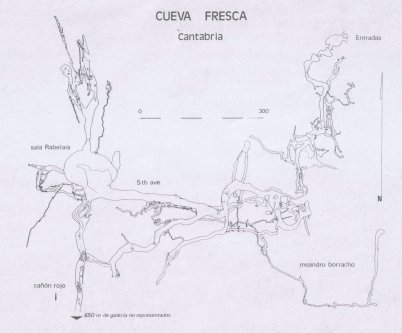 |
We did not come across as many formations as in the other caves. It is more sporting however with a number of traverses and bold steps. There is a through trip from Sima Tibia, high on the hill. We reached the huge, deep Sala Rabelais chamber and then the junction with the through trip route. There are fixed aids in place wherever necessary but some were a bit old and worn. We spent about 6-7 hours in the cave. On our return we found three new born kittens ensconced in the bumper of the van! We returned them safe and sound to the farm next to Casa Tomas where we assumed they had come from.
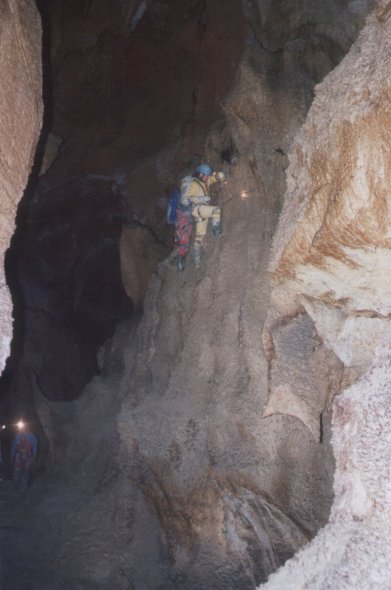 |
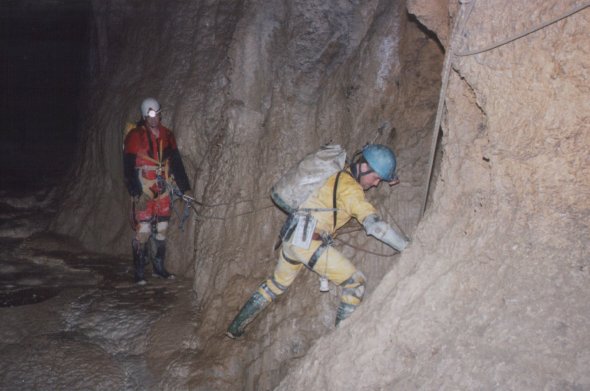 |
